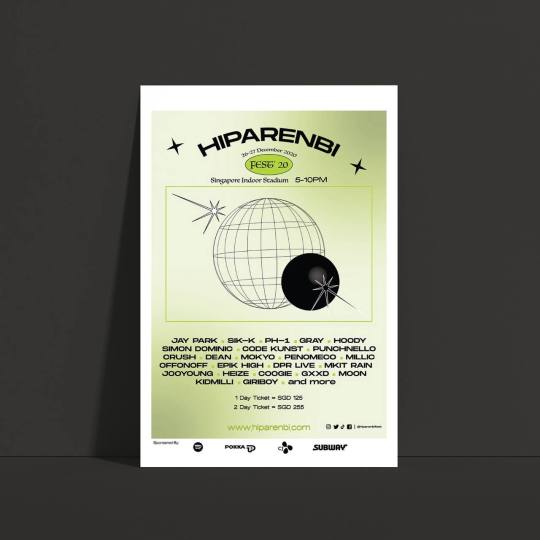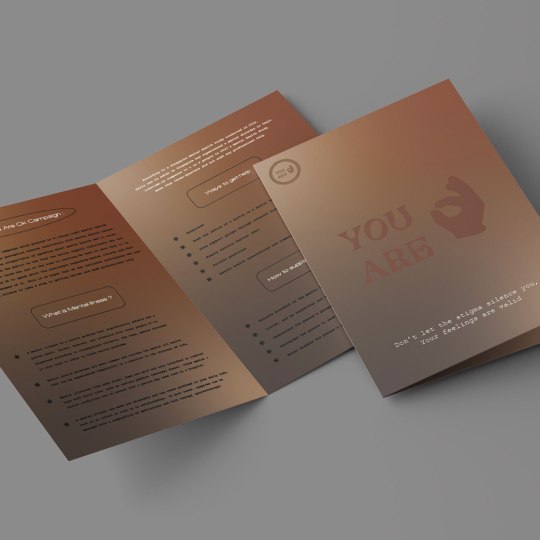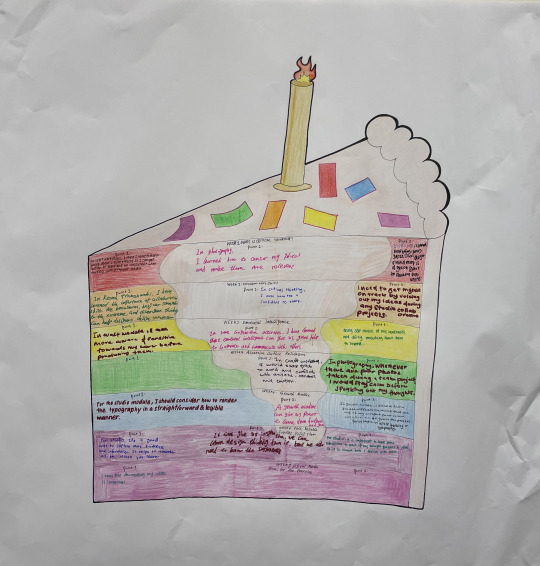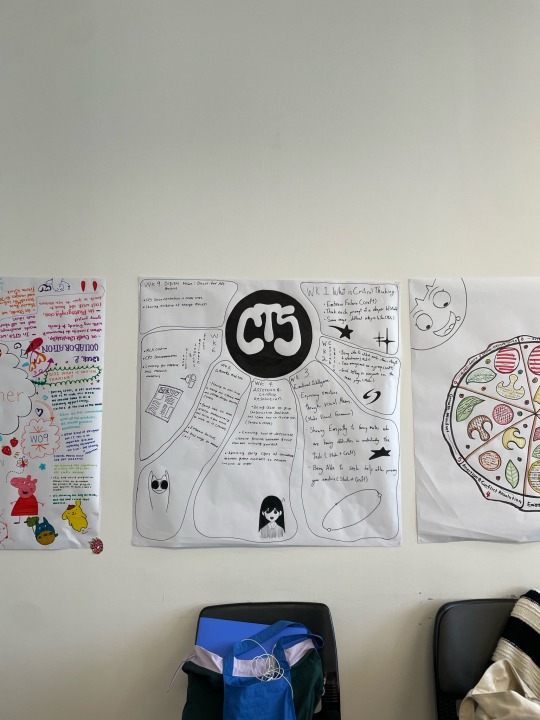Text
Week 12
Connect CTS A to your learning and professional journey
Group mindmap

Honestly, I still struggle with deciding on what I want to pursue in the future, a lot of thinking has been done over the years deciding on which area I want to venture into that will be something that is worth the 'risk' of trying, while also leading me to a comfortable life. I have always known since the start I wanted to pursue a career that is creative and at the same time non-repetitive, in a way I am exposed to different experiences throughout the job, that is why I took on the journey of learning courses like Visual Communication and Design Communication which are kind of vague in a way they teach different modules where you gain different skills which I can one day apply into a job that requires either all of them or apply the specific skill to a job such as a Photographer or Illustrator etc.
The kind of collaborative project I would like to do would definitely involve working on something Fashion or Music related. For fashion, it would be cool to see my designs come to life on clothes a designer made, the designer could focus on the style and silhouettes they want to deliver on the clothes while I focus on the graphics and lastly coming together on deciding what materials would best deliver our creation.
One example of an illustrator I follow, collaboration with Uniqlo
instagram
A project I did for a music festival in ITE


As for music, I would like to design the cover art of albums, and posters as well as work on merch. Another one would be designing for music festivals or events, which I have done before in my previous school project.
I think it would be fun working on these for the final-year projects as they best suit my interests. Firstly, I think it would be nice to see your work come to life and fun working on the collaterals. Second, the exposure and experience you get working together with clients from different industries. I think these experiences give you better insight and from there you kind of know which industry you want to design for and the kind of projects you work on.
A project I did for a mental health campaign in ITE


For Community Engagement and Professional Skills, what would always come to mind would be Mental Health. I had my fair share of it as well as heard the stories and experiences of people, friends, and families and the setbacks they face. I want to make use and contribute my design skills to create awareness around such a sensitive topic.
There is so much stigma and fear about speaking on mental health, and I believe such dated beliefs should not continue. Through my works, I wish to be the voice for those who are afraid to get help and hopefully, with the help of my designs and the Organizations/Institutions, they're able to shed light and educate everyone. Simultaneously, I would make a point to always highlight all the organizations and help that are free. Many who can't afford would often give up or are unaware as they stick to knowing that getting help in Singapore is expensive. But overtime that is slowly changing and there are places that offer help at a low cost or even free.
How CTS A might help me professionally when I apply Digital Media: Documentation for Art Practice. Firstly, it is important to document everything as it is easy for you and others to understand where the ideas derive from and their processes. Secondly, through these documentations and sketches, it can prove authenticity and not just stolen with no development shown.
The job scope of a graphic designer consists of understanding briefs and their requirements, from there visualizing and creating designs, logos, illustrations, and photos that clearly communicate the message clients want to put out for their audience.
CTS A can help me in my career when I constantly practice Critical Thinking, naturally, it would bring me bigger opportunities as I keep an open mind towards everything and can organize my thoughts in a systematic manner.
659 words
0 notes
Text
Week 11
Connect CTS A to all your other modules (and components)
For this week's mindmap, I did a few sketches to list out a few alternatives to separate our 7 different weekly topics clearly into an object for the mindmap. I drew a croissant, an octopus as well a rainbow cake. I could easily draw a normal cake with layers, but then decided the rainbow cake would be the best choice as it consists of seven different colours for all the topics and would be much more contrasting and readable. After pitching the idea to my group, we all agreed and decided to use it. On top of the 7 layers for each topic, we also had 3 points within the layer. Unfortunately, I lost my sketches and don't have a clear picture of it, but this was what I could find.



How I connect CTS A in other modules & components :




Studio
I apply Critical Thinking to observe and question the works and pin-ups surrounding me in the classroom from my classmates as well as other classes, seeing the different ways their lecturers deliver the same topic differently to their respective classes, personally that helps me to see from other's perspectives and learn the different ways I can do things just from seeing their thought process. I take inspiration from many different works and combine all the different details and elements in one to create my work.
Craft
In Craft, I try to apply Growth Mindset by exploring different modes of expression. For example, in mark making I stepped out of my comfort zone and used different objects I was not too sure would work well but still went forward with them as well as tried using the things I saw others using.
Photography
For Photography, I apply Emotional Intelligence by creating a schedule that I know I can follow alongside other modules, so I can know better in advance the time I can allocate to shoot my images.
318 words
0 notes
Text
Week 10
Discuss the seven weekly topics as a whole
To summarize the whole seven weeks of CTS A, I would still say have been the most beneficial and crucial set of skills anyone with common sense should be equipped with, it basically describes having to manage and process things in a proper and logical manner which I believe is the wisest way, and it correlates with my values. The topics that were touched on teach us a sense of openness in our mindsets to look at things not only from our own perspective but others' as well. Emotional Intelligence is important, and I think a lot of people lack it as they just prioritize intelligence, which to me is just being blatantly ignorant. Through emotional intelligence, we learn to be self-aware and regulate our emotions, as well as have the ability to empathize and understand different perspectives. My experience throughout the lessons has always been interesting and eye-opening, I get to see through the minds of others in their works and mind maps, seeing their thoughts and creativity in their drawings, always boggles me as it never crossed my mind to have thought of drawing or creating something in those ways. I never get tired of seeing how different and creative everyone is every single week.


Working in a group setting can be really fun and insightful, it brings in people with different minds, walks of life, personalities & perspectives all together. From there we can learn a lot from one another as we are constantly facing different answers from each person which is interesting to hear, from there we can also understand their thought processes. Personally, I take this as an opportunity to grow, be more creative, and not stick to our own sets of mindsets/thinking/beliefs all the time and take the time to explore new ways of thinking. I think it is a win-win situation as we can share with others our own set of skills/knowledge as well as listen & learn from others. Working with others is more efficient as the responsibilities are spread out equally, we can all agree and focus on working on what we are each good at, working with other people also allows us to receive and give support and motivation to others while working on tasks.

What I wish I could do better would definitely be more versatile in my styles and explore more mediums, I definitely like trying and exploring different things but once I try them and the results don’t meet my own standards I easily get discouraged and stick to the way I do things. I also wished I was more creative in all aspects, be it the way I think or the way I process and work on my craft, less uptight and burned out so I could live life to my fullest potential.
467 words
0 notes
Text
Emotional Intelligence
Q1. We talked about “Self-management”, “Self-awareness”, “Empathy” and “Relationship management”. Which aspect do you think you are strongest at, and which is something you should try to improve? Discuss with reference to today’s activities, and even your Studio collaborations.
I think the aspect I am strongest at would be having self-awareness. This is something that I think I naturally have, considering how I don’t like burdening anyone around me, so I would do the checking up on myself and making sure everything is alright before anyone would come at me for my doings. I like to do things properly and honestly low-key hate being perceived especially negatively, so I make sure I do the right things and am always aware of my mistakes so that it does not bleed onto others or affect anyone. One thing for sure, I need to improve on would be my self-management. I think I need to be more patient with myself and remember that I am a work in progress, sometimes I can be too hard on myself and do things that self-sabotage everything, especially when I have a hard time understanding my emotions and the way I do things. I have to prioritize and put myself first before anything as to protect my well-being, this way I can be more at peace and actually achieve the goals that I need and want that will definitely benefit me long term.
(199 words)
1 note
·
View note
Text
Growth Mindset
Q1. Describe an eventful moment you have experienced in this class, bearing in mind the key ideas of the day.
An eventful moment for today’s lesson would be carrying out the activity of drawing and redesigning logos that we often go to or purchase and the latter. The challenge was that we had to do so with our non-master hand. It was kind of fun trying to draw with my non-dominant hand, and I would never have thought of challenging myself in that way. After we were done and had to review our group's logos, I found myself liking one of my group mate's work as it was pretty nice and bold but, I didn’t expect my logo to be the chosen as the best one, and I was kind of happy that people didn’t think that it was done w my non-dominant hand.
(124 words)


Q2. Include selected images of your personal sketches, and explain them. In particular, which sketches did you like most? Which least? Why?
For the first sketch, I intended to just use the first initials of the name of the shop, and taking inspiration from the original logo making the T appear as the kebab meat still on the rotating metal rod and making the K appear as a kebab wrap. As for the second one, it's again just the kebab meat and a neon signboard on top, trying to mimic those street vendors selling kebabs with really bright signs. The third one is basically just a kebab stick with a knife cutting through. The sketch I like most would be the second one as it really mimics the street vendor vibes, and the least would be the last one as I think it looks just okay.
(124 words)
0 notes
Text
What is Critical Thinking?
Q1. Describe your understanding of critical thinking that you had before the class, and reflect on what you may have learned.
I already had some basic understanding of critical thinking beforehand, but through the lesson it refreshed my knowledge of it. To me, it is an important skill everyone should have and apply in their daily lives. Simply put, it is to carefully evaluate, question and analyse situations before any decision-making. Critical thinking to me means approaching issues in a systematic and rational manner before concluding with a decision. It is finding and questioning things beyond what is provided in front of us, and thinking of other possibilities for a situation. (90 words)
Q2. What have you learned about Mindfulness? How might you integrate this into your learning environment?
The knowledge I have gained about mindfulness can help me reduce stress and stay more engaged in my learning environment by calming my mind and body. In addition, it helps support better mental health by providing a simple way to manage and regulate my emotions. To me, it's more about bringing my attention and focusing on the present rather than living or reminiscing about what could have been done in the past or thinking too much about the future. (79 words)
Q3. Describe an eventful moment you have experienced in this class.
I would say working on the group activity together with new classmates would be the highlight, as I didn't expect myself to get quite outgoing with new people, but I tried my best and got to have great interactions with them. We managed to work together on our mind map with a classmate, though there was a bit of a language barrier, but with teamwork we got things done. (69 words)
(238 words)
0 notes
Text
Post Modernism
Post-modernism breaks the boundary of common design. It is very colourful, bold and an acute sensitivity to the role of ideology in asserting and maintaining political and economic power. While modernism art is more sleek that refers to a global movement in society and culture. Post-modernism focuses on abstract principles and goes past the lines of design rules. The topic shows narrative style that mixes elements of advertising, media, and technology. It also explores themes of craziness and fluidity.

ARTWORK: Raoul Hausmann
The artist's aim " was to destroy traditional values in art and to create a new art to replace the old. " This relates back to post-modernism as it goes against the rules of design. This is a unique perspective of thinking beyond what is expected in the design world.

For this example, the main focus of the design is the painted woman following the texts. The craziness of this design shows post-modernism as everything is layered together creating chaos.
In my opinion, design should be expressed in how we want it to be with freedom and no limits as creativity is endless. The work would be more authentic as there is no limitation or rules to follow.
193 words
0 notes
Text
Art Ecosystem
The art ecosystem refers to the interconnected network of individuals, organizations, institutions, and industries that contribute to the production, dissemination, and consumption of art. This includes artists, art collectors, galleries, museums, auction houses, art critics, curators, art historians, art educators, art publishers, and many others play a role in shaping the art and design world.
The art ecosystem is dynamic and constantly evolving and changing, influenced by a range of factors including cultural trends, technological advancements, economic conditions, and social and political events. It is shaped by a complex web of relationships and interactions between its various actors, and is characterized by a diversity of perspectives, interests, and values.
One of the key challenges facing the art ecosystem is to ensure that it remains inclusive and accessible, and that it reflects the diversity of the communities it serves. This requires a concerted effort to promote equity, diversity, and inclusion at all levels of the art world, and to create opportunities for artists from underrepresented backgrounds to have their work be recognized and valued. To build new audiences and cultivate a greater appreciation of the arts among the general public, education and outreach are also necessary, in order to help build new audiences and promote a greater appreciation of the arts among general public.

An example of what can contribute to Art Ecosystems to me would be Curbside Crafters.
The place holds a space for many different creatives to openly express their creativity and showcase and sell their works. This encourages diversity and brings people from all backgrounds to contribute to the Art Ecosystem.
263 words
0 notes
Text
Post Structuralism
To my understanding Post Structuralism is a philosophical movement that challenges the certainty and idealistic narrative of modernism, post-structuralism challenges certainty especially by focusing on language and the uncertainty inherent in the way that we conceive of and communicate ideas post-structuralists rejects the idea that language connects to an objective reality outside of oneself rather, they see language as a complex system of symbols that have evolved meaning through human processes.
In post-structuralism our understanding of reality is always heavily sometimes completely mediated through human forces we cannot objectively know something outside of ourselves. In post-structuralists our understanding of reality is always heavily sometimes completely mediated through human forces we cannot objectively know something outside of ourselves. Some post-structuralists hold onto standards that make different interpretations of reality more or less valuable according to their usefulness or fidelity while others question the concept of reality itself on a more extreme level.
Some of the key concepts and themes associated with post-structuralism include:
Deconstruction: the process of analyzing texts to reveal the inherent contradictions and instabilities in their meaning Difference: the idea that meaning is produced through the oppositional relationship between words or concepts Power: the ways in which power relations are inscribed in language and shape social and cultural structures Subjectivity: the idea that the self is not a fixed entity, but is instead constantly constructed through language and social practices.
Overall, post-structuralism has been influential in challenging the traditional ways of thought and providing new perspectives on how language, power, and social structures interact.
255 words
5 notes
·
View notes
Text
Summary
To summarize this module altogether, I felt like the past few lectures in WOII have been quite useful and beneficial for us as designers. It might seem a bit boring at the start, but when you take the time to really understand and absorb the topic, you realize how the things we never really thought about, actually play such a huge role and importance in design. Especially since the topics that are covered in these lectures mention quite a number of important things that revolve around design.
I also love that we learn about a new topic every week, most of the time I have not even heard of it or know much of the topic, but through these lectures I get a good introduction to the topics. As designers, our role is to communicate, and it is quite important that we broaden our minds for knowledge of the world and how we can communicate our message efficiently.
Not only do we need creative and technical skills and assets, but also have a strong understanding of topics when we start on projects and the importance of knowing the history and context behind them before using them for anything. As designers, I believe that we can't get too comfortable, it is important that we keep up to date with current design trends and what is happening around the world since we may also work in a variety of industries.
Having to work in many industries, we will have to collaborate with different professions, so it is good to be educated on these topics mentioned in WOII. I also loved how interactive the lessons were, like having to do the activities around the school facilities and that we had to all participate especially the mini presenting in our respective classes, it definitely helped me practice and gain confidence in voicing out my opinions, and I liked hearing how authentic the responses were when we had to answer individually. Overall, WOII has been beneficial, and I think it definitely gets the brain moving since it makes you think more outside the box.
349 words
0 notes
Text
Semiotics
Semiotics is the study of how signs or other symbolic systems of communication can make meaning and how we interpret them. It is a way how an idea or object can communicate just through a symbol or a sign, and what meaning it can be conveyed.

Semiotics mainly focuses on how humans use signs and symbols to express themselves, including how they employ metaphor, analogy, allegory, metonymy, symbolism, and other forms of visual communication. The study of communication as a whole, including the visual arts, graphic design, and fundamental visual literacy, includes semiotics. Graphic designers, artists, and others involved in visual communication must take into account how the interpretation of their works is affected by symbols, signs, and colours.

Especially in marketing and advertising, businesses that advertise have to effectively communicate their brand essence to the targeted demographics by learning how people from various cultural backgrounds interpret messages. The meaning of symbols also varies depending on the circumstance. Semiotics can, however, have a detrimental impact on a business because cultural preferences can influence whether or not the public loves or dislikes a company depending on its marketing. While developing products and marketing collateral for their brands, international organizations and businesses must take into account how various cultures interpret the different symbols and colours.
213 words
0 notes
Text
Aesthetics
Aesthetics is the philosophical study of beauty, art, and taste, it means a sense of perception and refers directly to the principles that govern the nature and appreciation of beauty.

It also takes into account issues of beauty and artistic taste, such as how to determine whether a work of art is actually autonomous - that is to say, whether it is not subject to political, moral, and religious factors. The definition of beauty often includes the idea that one should experience aesthetic pleasure when perceiving an object. The positive aesthetic value of beauty is contrasted with the negative aesthetic value such as ugliness.
Nevertheless, terms such as beautiful and ugly pose a problem at the outset since they seem too vague and subjective in their meaning to divide the world effectively into those that do, and those that do not, embody them.

Take for example, the photographer Cho Gi Seok, his work is continually in search of aesthetic beauty. His images stand out for their powerful composition, where everything from light and colour to subjects and attire is thought out in detail. He frequently returns to the concept of coexistence. From his point of view, everything around us—every flower, living creature, place, and digital object—is impacted by everything else, and that is what makes up our life. According to him, people, the environment, and even robots are all supposed to coexist. He constantly aspires to capture the beauty he imagines and aims to portray human existence from the perspective of his generation, and the diversity of Korean culture, as well as the beauty found in the equilibrium of opposites, are reflected in both his pictures of people and flowers.
281 words
2 notes
·
View notes